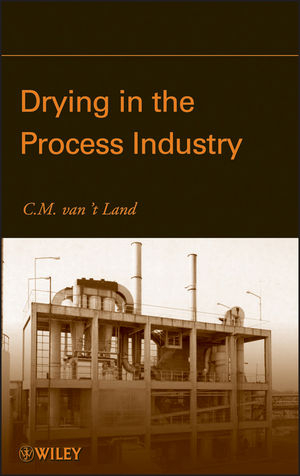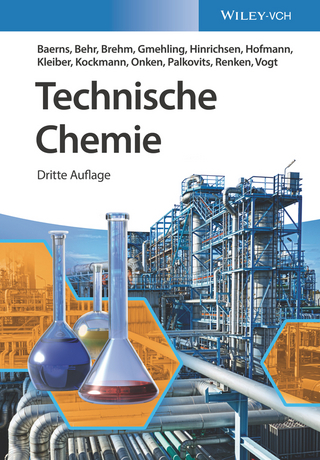
Drying in the Process Industry
John Wiley & Sons Inc (Verlag)
978-0-470-13117-6 (ISBN)
- Lieferbar (Termin unbekannt)
- Versandkostenfrei innerhalb Deutschlands
- Auch auf Rechnung
- Verfügbarkeit in der Filiale vor Ort prüfen
- Artikel merken
A comprehensive approach to selecting and understanding drying equipment for chemical and mechanical engineers
A detailed reference of interest for engineers and energy specialists working in the process industry field, Drying in the Process Industry investigates the current state of the art of today's industrial drying practices, examines the factors influencing drying's high costs in both equipment and energy consumption, and summarizes key elements for keeping drying operations under budget and performing at peak capacity safely while respecting the environment. Extensive coverage of dryer basics as well as essential procedures concerning the selection of industrial dryers—such as how to gather results of relevant laboratory measurements, carry out small-scale tests, and correctly size equipment—help to inform readers on criteria for generating scalable specifications that greatly assist buying decisions.
Drying in the Process Industry:
Takes a practical approach to drying equipment, from an author with four decades in the industry
Describes a diverse array of drying equipment (convective, like flash, spray, fluid-bed, and rotary; contact, like paddle and steam; radiation) from an engineer's perspective
Provides quick and ready access to drying technologies with references to more detailed literature
Treats drying in the context of the entire production process
True of all process facilities where drying plays an important role, such as those in the chemical, pharmaceutical, plastics, and food industries, the purchase of improper industrial drying equipment can significantly affect a manufacturer's economic bottom line. With the guidance offered in this book, engineers will be able to confidently choose industrial drying equipment that increases profits, runs efficiently, and optimally suits their needs.
C.M. VAN 'T LAND has run the seminar and consulting company Van 't Land Processing since 1999. Prior to that, he worked at Akzo Nobel Chemicals from 1968–2000 as process engineer, and later, process development manager and project leader. He is the author of Industrial Drying Equipment: Selection and Application and Industrial Crystallization of Melts.
Preface ix 1 Introduction 1
2 Drying as Part of the Overall Process 9
2.1 Residual Moisture / 9
2.2 Optimization of the Dewatering Step / 10
2.3 Process Changes to Simplify Drying / 10
2.4 Combination of Drying and Other Process Steps / 12
2.5 Nonthermal Drying / 15
2.6 Process Changes to Avoid Drying / 17
2.7 No Drying / 19
3 Procedures for Choosing a Dryer 21
3.1 Selection Schemes / 21
3.2 Processing Liquids, Slurries, and Pastes / 31
3.3 Special Drying Techniques / 33
3.4 Some Additional Comments / 34
3.5 Testing on Small-Scale Dryers / 37
3.6 Examples of Dryer Selection / 38
4 Convective Drying 41
4.1 Common Aspects of Continuous Convective Dryers / 42
4.2 Saturated Water Vapor Pressure / 43
4.3 Wet-Bulb Temperature / 44
4.4 Adiabatic Saturation Temperature / 46
4.5 Humidity Chart / 47
4.6 Water–Material Interactions / 49
4.7 Drying with an Auxiliary Material / 52
4.8 Gas Velocities / 54
4.9 Heat Losses / 55
4.10 Electrical Energy Consumption / 57
4.11 Miscellaneous Aspects / 59
4.12 Material Balance (kg·h−1) / 61
4.13 Heat Balance (kJ·h−1) / 61
4.14 Specific Heat of Solids / 63
4.15 Gas Flows and Fan Power / 64
4.16 Direct Heating of Drying Air / 65
5 Continuous Fluid-Bed Drying 67
5.1 General Description / 67
5.2 Fluidization Theory / 70
5.3 Drying Theory for Rectangular Dryers / 76
5.4 Removal of Bound Moisture from a Product in a Rectangular Dryer / 88
5.5 Circular Fluid-Bed Dryers / 90
6 Continuous Direct-Heat Rotary Drying 99
6.1 General Description / 99
6.2 Design Methods / 103
7 Flash Drying 117
7.1 General Description / 117
7.2 Design Methods / 120
7.3 Drying in Seconds / 122
7.4 Application of the Design Methods / 126
8 Spray Drying 133
8.1 General Description / 133
8.2 Single-Fluid Nozzle / 138
8.3 Rotary Atomizer / 143
8.4 Pneumatic Nozzle / 145
8.5 Product Quality / 149
8.6 Heat of Crystallization / 153
8.7 Product Recovery / 154
8.8 Product Transportation / 154
8.9 Design Methods / 155
9 Miscellaneous Continuous Convective Dryers and Convective Batch Dryers 163
9.1 Conveyor Dryers / 164
9.2 Wyssmont Turbo-Dryer / 169
9.3 Nara Media Slurry Dryer / 170
9.4 Anhydro Spin Flash Dryer / 172
9.5 Hazemag Rapid Dryer / 174
9.6 Combined Milling and Drying System / 176
9.7 Batch Fluid-Bed Dryer / 178
9.8 Atmospheric Tray Dryer / 182
9.9 Centrifuge–Dryer / 184
10 Atmospheric Contact Dryers 189
10.1 Plate Dryers / 189
10.2 Mildly Agitated Contact Dryers (Paddle Dryers) / 193
10.3 Vigorously Agitated Contact Dryers / 198
10.4 Vertical Thin-Film Dryers / 202
10.5 Drum Dryers / 204
10.6 Steam-Tube Dryers / 208
10.7 Spiral Conveyor Dryers / 212
10.8 Agitated Atmospheric Batch Dryers / 213
11 Vacuum Drying 217
11.1 Vacuum Drying / 219
11.2 Freeze-Drying / 232
11.3 Vacuum Pumps / 242
12 Steam Drying 251
12.1 Sugar Beet Pulp Dryer / 252
12.2 GEA Exergy Barr–Rosin Dryer / 255
12.3 Advantages of Continuous Steam Drying / 257
12.4 Disadvantages of Continuous Steam Drying / 257
12.5 Additional Remarks Concerning Continuous Steam Drying / 258
12.6 Eirich Evactherm Dryer / 258
13 Radiation Drying 263
13.1 Dielectric Drying / 264
13.2 Infrared Drying / 278
14 Product Quality and Safeguarding Drying 289
14.1 Product Quality / 289
14.2 Safeguarding Drying / 291
15 Continuous Moisture-Measurement Methods, Dryer Process Control, and Energy Recovery 313
15.1 Continuous Moisture-Measurement Methods for Solids / 313
15.2 Continuous Moisture-Measurement Methods for Gases / 321
15.3 Dryer Process Control / 327
15.4 Energy Recovery / 335
16 Gas–Solid Separation Methods 339
16.1 Cyclones / 340
16.2 Fabric Filters / 343
16.3 Scrubbers / 346
16.4 Electrostatic Precipitators / 349
17 Dryer Feeding Equipment 357
17.1 Fluid-Bed Dryers / 358
17.2 Direct-Heat Rotary Dryers / 360
17.3 Flash Dryers / 360
17.4 Spray Dryers / 361
17.5 Conveyor Dryers / 361
17.6 Hazemag Rapid Dryer / 363
17.7 Anhydro Spin Flash Dryer / 365
17.8 Plate Dryers / 365
17.9 Vigorously Agitated Contact Dryers / 365
17.10 Vertical Thin-Film and Drum Dryers / 365
Notation 369
Index 377
| Verlagsort | New York |
|---|---|
| Sprache | englisch |
| Maße | 155 x 231 mm |
| Gewicht | 658 g |
| Themenwelt | Naturwissenschaften ► Chemie ► Technische Chemie |
| Technik | |
| ISBN-10 | 0-470-13117-9 / 0470131179 |
| ISBN-13 | 978-0-470-13117-6 / 9780470131176 |
| Zustand | Neuware |
| Haben Sie eine Frage zum Produkt? |
aus dem Bereich


